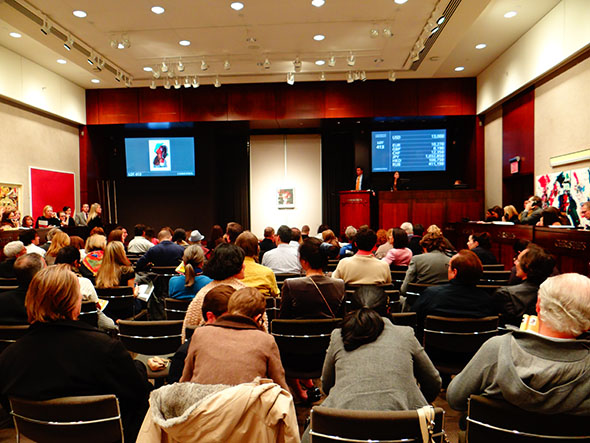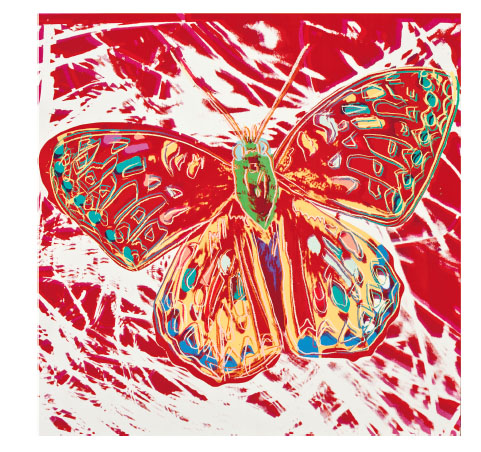
An eight-hour-long live auction held Monday at Christie’s of more than 350 Andy Warhol works raised $17 million for the Andy Warhol Foundation.
The day’s top selling piece was “Endangered Species: San Francisco Silverspot,” a painting of a butterfly, which went to a telephone bidder for $1,050,000. Warhol’s silkscreen “Three Targets,” which was estimated to sell at $1 million to $1.5 million, eventually sold for $800,000. His work “Jackie” from 1960 sold for $520,000 to a telephone bidder.
The November 12 auction marked the beginning of the sale of the entire Andy Warhol Foundation for the Visual Arts’ estate. The foundation decided to sell its collection through Christie’s in the hope of increasing its endowment to support the art market. With the sale, the foundation makes a bold move to focus almost exclusively on grant making.
“We have now chosen to mark the Foundation’s 25th anniversary year by expanding the scope of our art sales in order to increase future grant-making capacity,” said Michael Strauss, Chairman of the Board of the Andy Warhol Foundation in a statement.
The auction was separated into three categories: photographs, paintings and works on paper, and prints. A wide array of 356 pieces was sold for from $2,000 to over $1 million at the auction house at Rockefeller Center.

Most works from the foundation are lower-value items. Despite that, there were some prime pieces available.
The auction was expected to bring in about $20 million, and ended with a total result of $17,017,050. In contrast, one Warhol piece alone – his “Double Elvis” – was sold in May this year for $37 million at Sotheby’s.
The opening prices for Warhol’s paintings and works on paper were much higher than for most prints and photos, and fiercely bid for by art lovers over the phone, in the room and online.
By far, most bids and purchases came from telephone bidders from all over the world, including Germany, the U.K., France and Puerto Rico. Online bidders were the second largest group, and then came bidders in the room. In the salesroom, there was a lot of commotion as people came and left, depending on what pieces they were interested in. There were about 50 people in the room at a time, but it quickly filled up to a crowd of 100 art lovers for the last category, prints.
“People are more interested in their own time and with contemporary art they still have the chance to assemble a collection,” said Amy Capellazzo, chairman of contemporary art development at Christie’s. “Warhol is a global brand and everyone knows his name, that’s why it’s appealing to art buyers.”
This year marks the 25th anniversary of Warhol’s death. In addition to the auction, the Metropolitan Museum of Art is currently holding an exhibition titled “Regarding Warhol: Sixty Artists, Fifty Years.”
Though Warhol is best known for his pop art, some of his more controversial works were also on sale. Three works titled “Piss Painting,” urine on gesso on canvas, sold for $680,000, and $170,000 and $70,000 respectively. Another unusual work of art was titled “Cum Painting,” semen on gesso on canvas, which sold for $32,000.
“Warhol’s pieces are provocative. I want them because they’re a rare form of art and he did something that no artist before him dared to do,” said Aleksandr Lushnov, an art collector from Russia. Lushnov went to the public viewing of Warhol’s pieces a week earlier to choose what he wanted to bid for. In the end he purchased an untitled drawing of a man’s genitals for $11,000.
According to ArtTactic, an art market analysis firm, the contemporary art auction market generated over $1.26 billion in revenue in 2011, with Andy Warhol accounting for $336.3 million, or 27 percent, making him the third best-selling artist worldwide in terms of auction revenue.
Over 20,000 screen paintings, prints, drawings, and photographs that were owned by the foundation will be sold through live auctions, online auctions and private sales in the next few years, including works that have never been publicly displayed before. Many experts worried that such a large number of works would flood the market and reduce the value of Warhol works. Warhol was the leading artist in pop art is the 1960s, and also founded the acclaimed Interview magazine in 1969.
All sales combined are expected to generate around $100 million. The auction sale proceeds are expected to increase the foundation’s $225 million endowment to support its mission to advance the visual arts. Since its creation in 1987, the foundation has awarded nearly $250 million in grants to hundreds of museums and nonprofit arts groups. According to a press release by the foundation and Christie’s about their partnership, the Andy Warhol Foundation will also donate “significant works” to museums.
According to Capellazzo, the success of the Warhol auction stemmed from the fact that it offered pieces at affordable prices, around $10,000 to $15,000, for photos and some prints. “People who always wanted to own a Warhol but couldn’t afford it now have the chance to,” she said.
Jessica Wiese, an art collector and doctor from Munich, Germany, planned her 10-day-long trip to New York around the auction. “I came because I thought I’d have the chance to get a Warhol at a lower price,” said Wiese. She bid for two pieces, but they went over her limit of $15,000. “I buy art out of appreciation, not as an investment.”
The live auction was only the first step in ongoing sales. Starting in February 2013, Christie’s will expand its reach and Internet presence by holding auctions done exclusively online. At Monday’s auction, people from all over the world were able to participate live at the bidding, without having to be in the salesroom in New York.
“Most bids come from the telephone and online. People from all over the world can participate, and they get to stay anonymous, because they don’t want the world to know what they’re purchasing and for how much,” said Capellazzo.
Christie’s, founded in 1766, is doing exceptionally well at the moment in terms of sales and revenue figures. While Christie’s doesn’t report revenue or profit figures, it reports total sales twice a year. According to a July release, it sold $3.5 billion of fine and decorative art in the first half of 2012, which is an increase of 11.2 percent from 2011. The overall sales are split up in $2.8 billion in auction sales and $661.5 million in privately brokered art sales. Its private art sales were up 50 percent in comparison to last year.
Art is still seen as a luxury item and a status symbol. The recent economic recession has made people more aware of their spending. “The recession, as well as uncertainty among art collectors, are putting pressure on the art market right now,” said Benjamin Mandel, economist at the Federal Reserve Bank. According to Mandel, people have less money to spend on art and large purchases are held off because people are cautious. However, “contemporary art has driven a lot of growth in the art market and has done better in the economic downturn than other genres,” said Mandel.